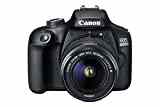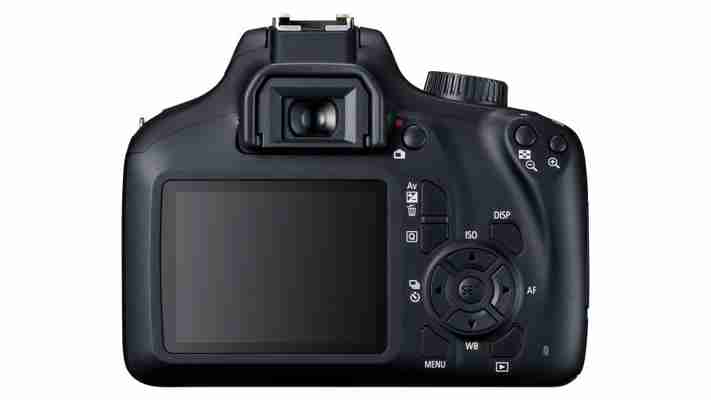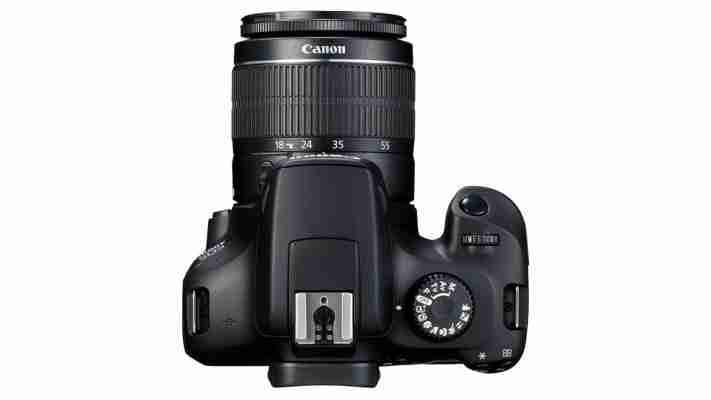With smartphones increasingly capable of sensational photography you get the sense camera makers are finding it ever harder to shift low-end DSLRs. Who needs the hassle of lugging around a bulky camera when there’s a decent one already in your pocket?
The Canon EOS 4000D is Canon’s attempt to sway some of those smartphone snappers. Emphasising features such as easy social-media sharing from the built-in Wi-Fi and a sensor that’s “19x larger than a typical smartphone’s”, Canon is thrusting this budget camera in the face of the Instagram generation. It’s just a shame many of its core features feel older than the audience it’s aimed at.
Canon EOS 4000D review: What you need to know
The 18-megapixel EOS 4000D sits at the very bottom of Canon’s DSLR range, just below the EOS 2000D, which is a wee bit odd given Canon’s traditional naming convention, where a higher number normally means a better camera.
As you might expect, we’re not talking about a camera that’s stacked with features. The built-in Wi-Fi is close as we come to a standout feature, allowing you to transfer photos to a smartphone or tablet with relative ease or even control the camera from your phone – if you don’t want to risk shutter shake when capturing long exposures, for example.
Other than that, it’s a no-frills DSLR – and I really do mean no-frills. In fact, this camera’s core specification is dated in many respects.
Canon EOS 4000D review: Price and competition
The EOS 4000D is about as cheap as new DSLRs come. It’s priced at £330 for the body only and £370 if you include the rather plasticky and insipid EF-S 18-55mm III lens. For the sake of £40, it’s just about worth having if you don’t already own something similar.
The next step up in the Canon range is the 24-megapixel 2000D, which is currently £370 or £470 with the superior and stabilised EF-S 18-55mm IS II Lens.
Rival cameras in this price bracket include the excellent 24.72-megapixel Nikon D3400, which costs £370 with its AF-P 18-55VR lens ( click here to read our full review ).


Canon EOS 4000D review: Features and design
So what does just over £300’s worth of camera get you? In truth, a very basic spec.
The 18-megapixel sensor inside this camera was first used in Canon cameras as far back as 2010, which sets the tone for the rest of the features on offer here.
The nine-point autofocus system is equally dated. It doesn’t stretch to the far corners of the frame, meaning you’ll either need to place your subjects either just off-centre or get used to re-framing once you’ve got the focus locked.
Autofocus is pretty sluggish by modern standards and the red dot that indicates when you’ve got a focus-lock isn’t easy to see in bright conditions. There’s a little bit too much guesswork involved for my liking.
Don’t think you can easily check focus on the camera’s LCD, either. It’s a horribly cramped and low-res screen. Even the most beautifully focused shot can look grainy on the 3in, 230k display, meaning you have to zoom right in to check sharpness.

And, note, we say screen, not touchscreen. The menus have to be navigated via the buttons on the back of the camera, in another throwback to the pre-iPhone era. If Canon is trying to attract the smartphone junkies, this is a strange way of doing it.
The body itself is fine. It’s all smooth plastic but the buttons are well spaced and responsive and there’s a rubber grip on the front of the body to prevent it slipping free. But more economies have been made on the lens mount: it’s plastic, not metal, which could be a worry if you’re changing lenses frequently.
The bundled EF-S 18-55mm III lens is about as lightweight as they come, with a very unsatisfying zoom action. With no switch to lock the zoom, it’s easy to accidentally knock while set up on a tripod and ruin your framing. And the autofocus makes a noise like a rat scratching a tin can.
One omission we’re not keen on is the removal of the dedicated power switch. OFF is now just another option on the function dial that allows you to choose between the camera’s various shooting modes. That’s irritating if you’ve got the camera set up in a particular mode and just want to flick it off for a minute or two to save battery. If you’re in video mode, you’ve got to turn the juddery dial a full 180-degrees just to turn it off, adding a degree of unnecessary faff.

There are no real surprises in the shooting modes. All the regulars are there, plus a Food mode that “makes food look fresh and vibrant”, if you’re the kind of person who goes to restaurants to photograph their food rather than eat it.
The Creative Auto mode is a compromise between manual and automatic controls, letting you select the degree of background blur – beginner language for the size of the aperture. This mode also lets you pick from filters such as Vivid, Soft, Cool and Monochrome if you can’t be bothered to edit after the event and know what you want your photo to look like. There are plenty of post-shoot effects you can apply in-camera, too.
Sports fans may want to look elsewhere. A maximum burst rate of three frames per second is going to struggle to capture the most portly of Sunday League footballers, let alone a fast car. It’s slow by today’s standards.
And what about that wireless connection? Switch the camera’s Wi-Fi function on and the camera turns into a Wi-Fi hotspot to which you can connect your phone or tablet. Using Canon’s slightly clunky Camera Connect app (available on both iOS and Android), you can then browse through images taken on the camera, download pictures to the phone or even use the phone as a camera remote control. Ironically, shooting through the smartphone offers touch autofocus – you can dab the screen to set the focus point – something the camera itself omits.
Canon EOS 4000D review: Photo quality
The crux of any camera is the image quality and although I’ve so far had plenty of criticism for the EOS 4000D this is an area in which it does not disappoint.
Canon always does a decent job of balancing colours and whether you’re shooting inside in relatively dank conditions or you’re out in the bright sunlight, the photos are vibrant without creeping over into over-saturation. The corn in the fields of our test shot doesn’t tip over into an orangey mass, for example, while the sky retains a deep blue.
Exposures are generally well judged, too, with just the right balance between highlights and shadows, even in high-contrast scenes such as the sheep beneath the tree in our test image.
Even when the sensitivity is cranked up to ISO 6400 (the camera’s maximum) noise doesn’t spoil the image. It’s there and visible on close inspection but it doesn’t drag the image down.
Be wary of the preset modes, through. The food mode robbed a ripening tomato of subtle shades of orange as it ramped up the promised vibrance. Adjusting the preset to a ‘warmer’ image simply gave the whole shot an orange tint.
Canon EOS 4000D review: Video quality
The EOS 4000D is not a vlogger’s dream with resolution is limited to Full HD (1,920 x 1,080) at 25fps. There’s no mic input – you’re stuck with the internal mic, which picks up every slight breeze – and the supplied kit lens isn’t stabilised, meaning you’ll see plenty of unsettling wobble when shooting without a tripod.
Video quality is perfectly adequate if the camera is popped on a tripod or used with a stabilised lens, but note there’s no continuous autofocus. If your subject moves, you’ll need to prompt the autofocus by depressing the shutter button, which leads to lens noise on your video and focus hunting in your footage. Both are far from ideal.
Click here for our Canon EOS 4000D test video
Canon EOS 4000D review: Verdict
Canon is hoping the EOS 4000D will spark the joy of DSLR photography into smartphone snappers. I’m not so sure.
The camera is found wanting in many areas. Its autofocus is limited and slow, the screen is fuzzy and lacks touch controls, the burst rate is sluggish. This a 2010 camera wrapped up in a 2018 body.
That said, the price is more than competitive and it is capable of taking decent photos. Vloggers and videographers should look elsewhere but for stills photography on a budget it’s a reasonable proposition.
Still, I’d be tempted instead to scour the second-hand market rather than buy the EOS 4000D new. You could pick up a second-hand EOS 70D for around the same price and gain vastly greater all-round performance, a touchscreen and audio connections. If you want to feel the delight of DSLR photography, you’ll need to reach a little higher than this.
Canon EOS 4000D: Specifications | |
| CCD effective megapixels | 18.0 megapixels |
| CCD size 22.3x14.9mm | |
| Viewfinder | optical |
| Viewfinder magnification, coverage | 0.80x, 95% |
| LCD screen size | 2.7in |
| LCD screen resolution | 230,000 pixels |
| Articulated screen | No |
| Live view | Yes |
| Optical zoom | 3.0x |
| Zoom 35mm equivalent | 29-82.5mm |
| Image stabilisation | optical, in kit lens |
| Maximum image resolution | 5,184 x 3,456 |
| File formats | JPEG, RAW; QuickTime (AVC) |
| Memory slot | SDXC |
| Mermory supplied | none |
| Battery type | Li-ion |
| Battery Life (claimed) | 500 shots |
| Connectivity | USB, mini HDMI, |
| Body material | plastic |
| Lens mount | Canon EF-S |
| Focal length multiplier | 1.6x |
| Kit lens model name | Canon EF-S 18-55mm III Lens f/3.5-5.6 |
| Accessories | HDMI cable, neck strap |
| Weight | 436g (body only) |
| Size | 129x102x77mm |
| Warranty | one year RTB |
| Price | £329 (body only) |
| Supplier | |
| Details | |
| Camera Controls | |
| Exposure modes | program, shutter priority, aperture priority, manual |
| Shutter speed | 30 to 1/4,000 seconds |
| ISO range (at full resolution) | 100 to 6400 |
| Exposure compensation | +/-5 EV |
| White balance | auto, 6 presets with fine tuning, manual |
| Manual focus | Yes |
| Closest macro focus | 25cm |
| Auto-focus modes | 9-point (1 cross-type) |
| Metering modes | evaluative, partial, centre-weighted |
| Drive modes | single, continuous, self-timer |
